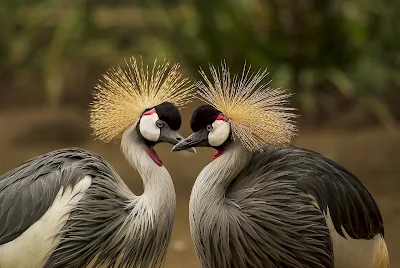Beyond the Horizon: Delving into the Reasons
Behind Bird Extinction
Birds, those marvelous
creatures that fill our skies with color and song, are facing an unprecedented
crisis. Every year, species after species inch closer to the brink of
extinction, leaving us to wonder: what is causing this alarming decline? In
this article, we will explore the myriad of reasons why birds are disappearing
from our world, from habitat loss to climate change, pollution, hunting,
invasive species, disease, and the critical lack of awareness and conservation
efforts.
Before delving into the
various factors contributing to bird extinction, it's essential to understand
the gravity of the situation. Birds play a crucial role in ecosystems
worldwide, from pollination and seed dispersal to controlling insect
populations and maintaining biodiversity. However, their populations are
plummeting at an alarming rate, with many species facing imminent extinction.
1.
Habitat Loss
1.1
Deforestation
One of the primary
drivers of bird extinction is the rampant destruction of their natural habitats.
Deforestation, driven by logging, agriculture, and urban expansion, robs birds
of their homes and vital resources. As forests disappear, so too do the birds
that depend on them for food, shelter, and breeding grounds.
1.2
Urbanization
The relentless march of
urbanization further compounds the problem, replacing forests, wetlands, and
grasslands with concrete jungles. Fragmented habitats and increased human
activity disrupt bird populations, leading to decreased nesting sites, food
scarcity, and heightened vulnerability to predators and pollution.
2.
Climate Change
2.1
Impact on Migration Patterns
Climate change disrupts
the delicate balance of ecosystems, altering weather patterns and habitats
crucial for bird migration. As temperatures rise, birds struggle to find
suitable breeding grounds and food sources along their migration routes,
leading to population declines and potential extinctions.
2.2
Altered Breeding Seasons
Rising temperatures and
erratic weather patterns also impact breeding seasons, throwing bird
reproduction cycles out of sync with essential resources like food availability
and nesting sites. This mismatch reduces breeding success rates, exacerbating
population declines across various bird species.
3.
Pollution
3.1
Air Pollution
Pollution, both in the
air and on the ground, poses a significant threat to bird populations
worldwide. Air pollution from industrial emissions and vehicle exhausts not
only degrades habitat quality but also directly harms birds through respiratory
issues and toxin exposure.
3.2
Water Pollution
Water pollution,
stemming from agricultural runoff, industrial waste, and plastic contamination,
contaminates freshwater sources crucial for birds' survival. Polluted water
bodies lead to reduced prey availability, reproductive problems, and
bioaccumulation of toxins in bird populations, contributing to their decline.
4.
Hunting and Poaching
4.1
Overexploitation
Despite legal
protections, birds still fall victim to overhunting and poaching for food,
feathers, and exotic pets. Unsustainable harvesting practices drive many
species to the brink of extinction, disrupting ecosystems and undermining
conservation efforts.
4.2
Illegal Wildlife Trade
The illegal wildlife
trade exacerbates the problem, with rare and endangered bird species fetching
exorbitant prices in black markets worldwide. Poachers exploit legal loopholes
and lax enforcement to profit from the illicit trade, pushing vulnerable bird
populations closer to extinction.
5.
Invasive Species
5.1
Competition for Resources
Invasive species pose a
formidable threat to native bird populations by outcompeting them for resources
such as food, nesting sites, and habitat. Species like rats, cats, and snakes
prey on vulnerable bird eggs and nestlings, driving native species towards
local extinction in invaded areas.
5.2
Predation
In addition to resource
competition, invasive predators directly prey on native bird species,
decimating populations and disrupting ecosystems. Without natural predators to
keep their numbers in check, invasive species wreak havoc on vulnerable bird
populations, accelerating their decline.
6.
Disease
6.1
Spread of Avian Diseases
The spread of avian
diseases, facilitated by global trade and human-mediated movement, poses a
severe threat to bird populations worldwide. Diseases like avian influenza and
West Nile virus can devastate entire bird populations, leading to widespread
mortality and population declines.
6.2
Impact of Human Diseases
Furthermore, human
diseases like malaria and Lyme disease can indirectly affect bird populations
by altering ecosystems and vector dynamics. Changes in disease prevalence and
distribution can disrupt bird communities, leading to cascading effects on ecosystem
health and stability.
7.
Lack of Awareness and Conservation
7.1
Education and Advocacy
Despite the growing
awareness of environmental issues, many people remain unaware of the gravity of
the bird extinction crisis. Education and advocacy efforts are crucial in
raising public awareness and mobilizing support for conservation initiatives
aimed at protecting bird habitats and populations.
7.2
Conservation Efforts
While the challenges
facing bird conservation are daunting, concerted conservation efforts offer
hope for the future. From habitat restoration and captive breeding programs to
legislative protections and community-based initiatives, various strategies can
mitigate the threats facing birds and promote their long-term survival.
In conclusion, the
reasons behind the alarming decline in bird populations are multifaceted and
interconnected, driven by human activities and environmental factors. To
prevent further extinctions and safeguard the diversity of avian life,
concerted action is needed at local, national, and global levels. By addressing
the root causes of bird extinction and prioritizing conservation efforts, we
can ensure that future generations inherit a world teeming with vibrant
birdlife.
FAQs
(Frequently Asked Questions)
1. What are the main
threats to bird populations worldwide?
The
main threats to bird populations include habitat loss, climate change,
pollution, hunting and poaching, invasive species, disease, and the lack of
awareness and conservation efforts.
2. How can individuals
help protect bird populations?
Individuals
can help protect bird populations by supporting conservation organizations,
creating bird-friendly habitats in their communities, advocating for
sustainable land use practices, and reducing their carbon footprint.
3. Are there any success
stories in bird conservation?
Yes,
there are several success stories in bird conservation, including the recovery



